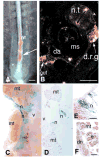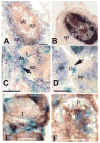Paraxial mesoderm contributes stromal cells to the developing kidney
- PMID: 19272374
- PMCID: PMC2677135
- DOI: 10.1016/j.ydbio.2009.02.034
Paraxial mesoderm contributes stromal cells to the developing kidney
Abstract
The development of most, if not all, tubular organs is dependent on signaling between epithelial and stromal progenitor populations. Most often, these lineages derive from different germ layers that are specified during gastrulation, well in advance of organ condensation. Thus, one of the first stages of organogenesis is the integration of distinct progenitor populations into a single embryonic rudiment. In contrast, the stromal and epithelial lineages controlling renal development are both believed to derive from the intermediate mesoderm and to be specified as the kidney develops. In this study we directly analyzed the lineage of renal epithelia and stroma in the developing chick embryo using two independent fate mapping techniques. Results of these experiments confirm the hypothesis that nephron epithelia derive from the intermediate mesoderm. Most importantly, we discovered that large populations of renal stroma originate in the paraxial mesoderm. Collectively, these studies suggest that the signals that subdivide mesoderm into intermediate and paraxial domains may play a role in specifying nephron epithelia and a renal stromal lineage. In addition, these fate mapping data indicate that renal development, like the development of all other tubular organs, is dependent on the integration of progenitors from different embryonic tissues into a single rudiment.
Figures




References
-
- Bard J. A new role for the stromal cells in kidney development. Bioessays. 1996;18:705–7. - PubMed
-
- Boenisch T. Pretreatment for immunohistochemical staining simplified. Appl Immunohistochem Mol Morphol. 2007;15:208–12. - PubMed
-
- Boyle S, Misfeldt A, Chandler KJ, Deal KK, Southard-Smith EM, Mortlock DP, Baldwin HS, de Caestecker M. Fate mapping using Cited1-CreERT2 mice demonstrates that the cap mesenchyme contains self-renewing progenitor cells and gives rise exclusively to nephronic epithelia. Dev Biol. 2008;313:234–45. - PMC - PubMed
-
- Brand-Saberi B, Wilting J, Ebensperger C, Christ B. The formation of somite compartments in the avian embryo. Int J Dev Biol. 1996;40:411–20. - PubMed
Publication types
MeSH terms
Grants and funding
LinkOut - more resources
Full Text Sources
Other Literature Sources

